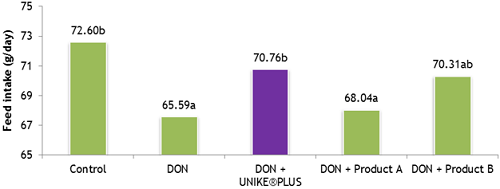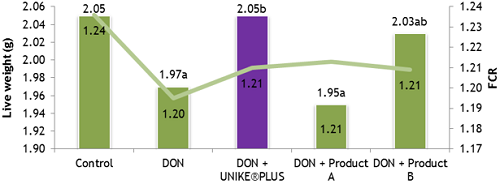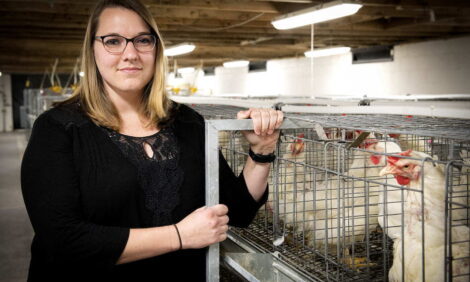



Mycotoxins: Everlasting Problem in Poultry Nutrition
The current mycotoxin situation in the EU is dramatic and any corn or wheat imported from Eastern or Central Europe might contain extremely high concentrations of deoxynivalenol (DON) and zearalenone (ZEN).Both DON and ZEN mycotoxins belong to fusarium mycotoxins which are structurally diverse and a chemically distinct group of fungal metabolites.
Economically important fusarium mycotoxins include trichothecenes, zearalenone and fumonisins.
DON (vomitoxin) and its acetylated forms are the most commonly found trichothecenes in grains used for poultry feeds.
The results of a recent NUTRIAD mycotoxin survey showed that 100 per cent of maize samples collected in Poland in January 2015 were contaminated with DON and ZEN.
None of the samples contained aflatoxin B1 (AfB1) and ochratoxin A (OTA). Exactly 25 per cent of samples contained FB1.
The average concentrations of all discovered mycotoxins were medium to high while the highest concentration of DON found in one of the samples reached 7900 μg/kg.
T-2 toxin, a mycotoxin extremely toxic in poultry was found in 63 per cent of the samples; its maximum concentration reached 120 μg/kg. This level of concentration could be significantly high for poultry or other monogastric animal species.
Of even more interest was contamination by zearalenone; 100 per cent of samples were contaminated and the highest analysed concentration was 2600 μg/kg. The average ZEN contamination was 291μg/kg and this level can be considered medium to high risk for breeding poultry.
Fusarium mycotoxin in poultry
These days poultry diets contain much higher inclusion of maize and maize byproducts of DDGS than swine diets.
This information forces us to think about how feed containing medium to high concentration of fusarium mycotoxins will affect poultry.
Earlier experiments, conducted for short periods or using single purified compounds, showed that poultry were resistant to DON.
More recent experiments, utilising naturally contaminated grains fed to poultry for extended periods, have shown that combinations of fusarium mycotoxins pose significant risks to poultry performance and health.
Turkeys appear to be more sensitive to fusarium mycotoxicoses than chickens, while ducks have shown to be the most resistant poultry species. Let’s talk about turkey then.
Are turkeys sensitive to fusarium mycotoxins?
Turkeys are more sensitive to fusarium mycotoxins than other avian species. Earlier reports suggested that turkey poults could tolerate 5 mg/kg DON in naturally contaminated wheat based diets without any significant changes in feed intake or body weight gain (Hamilton et al., 1985).
However, increasing proportions of artificially contaminated wheat in turkey diets up to 5.4 mg/kg DON and 0.4 mg/kg ZEN resulted in a dose dependent decrease in body weight gain (Dänicke et al., 2007).
Even lower levels of DON, combined with 15-acetyl-DON and ZEN, in naturally contaminated diets caused decreased body weight gain, increased plasma uric acid, and increased relative weight of the gizzard and bursa of Fabricius (Girish et al., 2008b).
Feeding highly contaminated grains to turkeys for 12 weeks reduced growth rates in all growth phases. Body weight gain decreased as early as the third week of feeding (Chowdhury and Smith, 2007).
Fusarium mycotoxins affect cell-mediated immunity more than humoral immunity. Deoxynivalenol can induce changes in brain neurochemistry which may be related to altered behaviour and emotional stress in turkeys.
Comparable findings in brain neurochemistry have been described in layers fed naturally contaminated diets (Yegani et al., 2006).
Feeding naturally contaminated diets containing 3.3 mg/kg DON, and lesser amounts of 15-acetyl-DON and ZEN, reduced villus heights in the duodenum of turkey poults in the starter phase and in the jejunum in both the starter and grower phases (Girish and Smith, 2008).
These birds had reduced growth rate (Girish et al., 2008b). To conclude, the main negative effects of fusarium mycotoxins in turkey are decreased daily weight gain, lower final weight and finally worse FCR. Can these negative mycotoxin effects be prevented?
Successful mycotoxin solution in turkey
In the currently described experiment 1596, one-day-old Hybrid tom turkeys were randomly placed into 38 floor pens (42 poults/pen).
Each pen was assigned to 1 of 5 treatments in a randomised complete block design with pen blocked by room and location within room. Basal feed was prepared using uncontaminated or naturally contaminated maize. The treatments were applied to a standard turkey starter diet (Table. 1).
Table 1 – Experimental design

* Product A: based on yeast cell walls
** Product B: based on diatomaceous earth, bentonite, inactivated yeasts, silymarin and algae extract
The treatments were applied to a standard turkey starter diet. Turkey poults and feeders were weighed by pen at placement, and then once per week throughout the five-week trial. Data was analysed by ANOVA with contrasts used to compare the DON treatment to each of the 3 products.
Turkey fed the UNIKE®PLUS treatment consumed more feed compared to those that were fed the DON contaminated diet (Figure. 1; P<0.05). However, feed consumption of birds fed Products A or B was not different from the DON treatment (P>0.10).
With higher average daily feed intake, birds assigned to the UNIKE®PLUS treatment had higher average daily gain and higher final body weight compared to the highest DON treatment (Figure. 2; P<0.10).
The rate of average daily gain and body weight of turkey fed the other 2 additives (Products A or B) were not different from the high DON diet. There were no statistically significant differences in feed efficiency between treatments (Figure.2).

Figure 1 - The effect of DON and mycotoxin deactivators on daily feed intake in young turkeys poults (g). a-b Different superscripts above the columns mean statistically significant differences (P≤0.05).

Figure 2 - The effect of DON and mycotoxin deactivators on body weight (g) and FCR of young turkeys poults. a-b Different superscripts above the columns mean statistically significant differences (P≤0.1).
Conclusion
This trial demonstrated the negative influence that DON (and possibly other trichotecenes) has on feed consumption and the subsequent impact this has on the feed intake and growth in young turkey poults.
The mycotoxin deactivator UNIKE®PLUS reduced these negative effects and clearly performed better than two other common brands of mycotoxin deactivators.
This year, special attention should be paid to contamination of feeds by DON and ZEN and appropriate measures taken to mitigate against the effects of their presence in animal feeds. The last possible line of defense is the detoxification of mycotoxins in vivo.
The addition of proven mycotoxin deactivators to animal feeds is a very common method to prevent mycotoxicosis and is an effective strategy to keep mycotoxin risk low under any and all conditions.
References
- CHOWDHURY, S.R. and SMITH, T.K. (2007) Effects of feed-borne fusarium mycotoxins on performance, plasma chemistry and hepatic fractional protein synthesis rates of turkeys. Canadian Journal of Animal Science 87: 543-551.
- DÄNICKE, S., VALENTA, H., UEBERSCHÄR, K.H. and MATTHES, S. (2007) On the interactions between fusarium toxin-contaminated wheat and non-starch-polysaccharide hydrolysing enzymes in turkey diets on performance, health and carryover of deoxynivalenol and zearalenone. British Poultry Science 48: 39–48.
- GIRGIS, G.N., SHARIF, S., BARTA, J.R., BOERMANS, H.J. and SMITH, T.K. (2008) Immunomodulatory effects of feed-borne fusarium mycotoxins in chickens infected with coccidia. Experimental Biology and Medicine 233: 1411-1420.
- GIRISH, C.K., SMITH, T.K., BOERMANS, H.J. and KARROW, N.A. (2008b) Effects of feeding blends of grains naturally contaminated with fusarium mycotoxins on performance, hematology, metabolism and immunocompetence of turkeys. Poultry Science 87: 421-432.
- GIRISH, C.K. and SMITH, T.K. (2008) Effects of feeding blends of grains naturally contaminated with fusarium mycotoxins on small intestinal morphology of turkeys. Poultry Science 87: 1075–1082.
- HAMILTON, R.M.G., TRENHOLM, H.L., THOMPSON, B.K. and GREENHALGH, R. (1985) The tolerance of White Leghorn and broiler chicks, and turkey poults to diets that contained deoxynivalenol (vomitoxin)-contaminated wheat. Poultry Science 64: 1840-1852.
- YEGANI, M., CHOWDHURY, S.R., OINAS, N., MACDONALD, E.J. and SMITH, T.K. (2006) Effects of feeding grains naturally contaminated with fusarium mycotoxins on brain regional neurochemistry of laying hens, turkey poults and broiler breeder hens. Poultry Science 85: 2117-2123.
Radka Borutova, Business development manager, NutriAd Belgium









